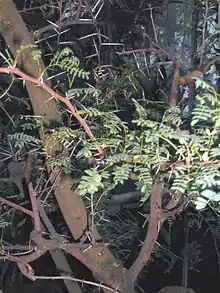Vachellia horrida
Vachellia horrida is a low spreading shrub or sometimes tree native to both the wet and dry scrublands of tropical to subtropical East Africa.[4] Common names for it are Cape gum, Karroo Thorn and dev-babul.[5] It is also found elsewhere in Africa, Asia, India and South America.[3] It frequently has stipular spines 9.5 cm long.[4][6] V. horrida is an important browse plant in the tropics, particularly during the dry season.[7]
| Vachellia horrida | |
|---|---|
 | |
| Scientific classification | |
| Kingdom: | Plantae |
| Clade: | Tracheophytes |
| Clade: | Angiosperms |
| Clade: | Eudicots |
| Clade: | Rosids |
| Order: | Fabales |
| Family: | Fabaceae |
| Subfamily: | Caesalpinioideae |
| Clade: | Mimosoid clade |
| Genus: | Vachellia |
| Species: | V. horrida |
| Binomial name | |
| Vachellia horrida | |
| Subspecies[2] | |
| |
 | |
| Range of Vachellia horrida | |
| Synonyms[3] | |
Uses
Vachellia horrida is used as forage for livestock, for its wood and for fuel.[8] Because of its huge thorns, it makes an excellent protective hedge. It used to be the most important tree for the tanning industry in South Africa, but extract from its bark leaves the leather with a rather bad smell. The tree produces good gum, but it is yellowish in color.[6]
References
- Kyalangalilwa B, Boatwright JS, Daru BH, Maurin O, van der Bank M (2013). "Phylogenetic position and revised classification of Acacia s.l. (Fabaceae: Mimosoideae) in Africa, including new combinations in Vachellia and Senegalia". Bot J Linn Soc. 172 (4): 500–523. doi:10.1111/boj.12047.
- "legumeweb_6.00_fam_f2.shtml [ILDIS]". www.ildis.org.
- "ILDIS LegumeWeb (version 10)". www.ildis.org.
- Dharani, Najma (January 2006). Field Guide to Acacias of East Africa. Struik Publishers. ISBN 978-1-77007-174-2.
- Mifsud, Stephen (2002-08-23). "Acacia karroo (Karroo Thorn) : MaltaWildPlants.com - the online Flora of the Maltese Islands". www.maltawildplants.com. Retrieved 2021-12-27.
- Google Books Select Extra-tropical Plants Readily Eligible for Industrial Culture Or Naturalization By Ferdinand von Mueller
- Getachew, G.; H. P. S. Makkar; K. Becker (2002). "Tropical browses: contents of phenolic compounds, in vitro gas production and stoichiometric relationship between short chain fatty acid and in vitro gas production". Journal of Agricultural Science. 139 (3): 341–352. doi:10.1017/S0021859602002393. S2CID 84543893.
- Madras Naturalists' Society Archived April 6, 2007, at the Wayback Machine